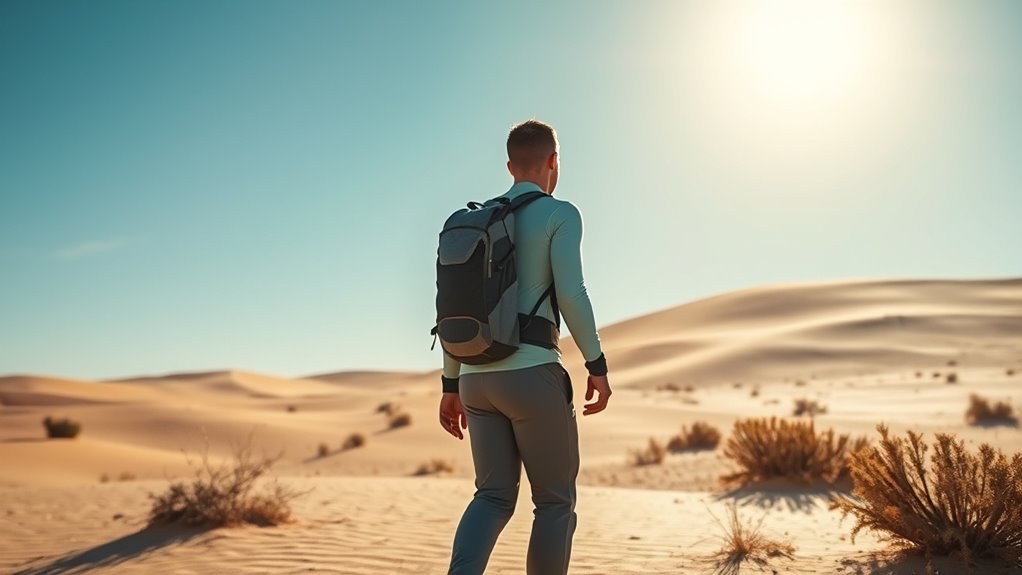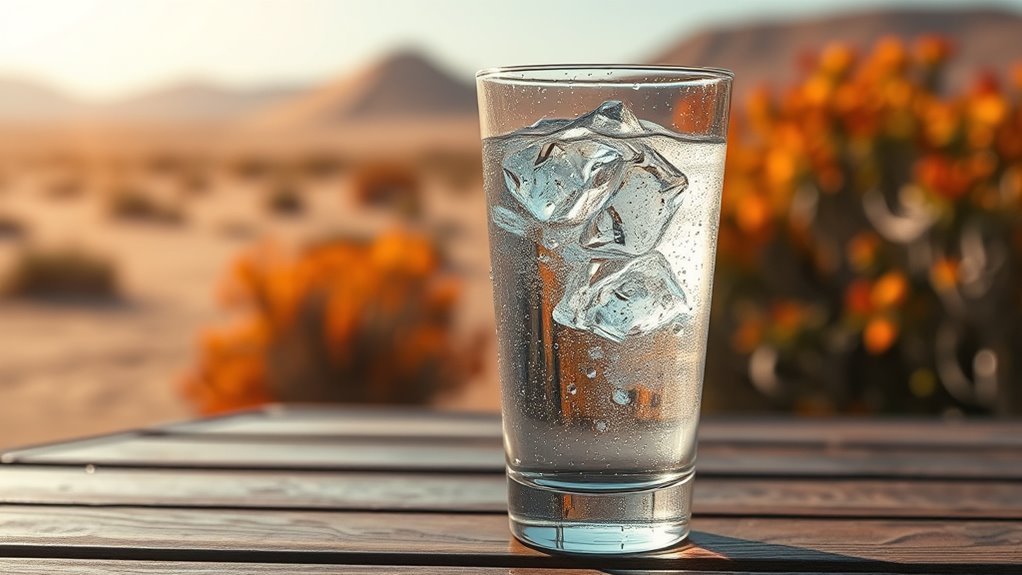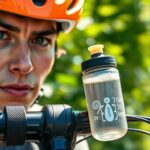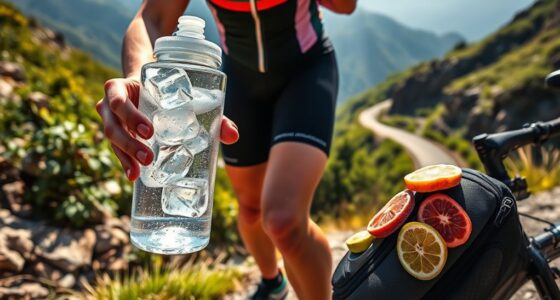In hot, humid climates, you need to hydrate early and regularly, replenishing electrolytes lost through sweating with sports drinks or snacks, and schedule drinking every 15-20 minutes during activity. In cooler environments, focus on steady, small sips throughout the day, as you lose less fluid. Tailoring your hydration to the climate helps prevent dehydration, cramps, and fatigue. To master effective hydration strategies for any climate, continue exploring these essential tips.
Key Takeaways
- In hot, humid climates, prioritize electrolyte-rich drinks and start hydration early before feeling thirsty.
- Schedule regular fluid intake (every 15-20 minutes) during activity to prevent dehydration in hot environments.
- Cooler climates require consistent, small sips of water throughout the day, even without thirst.
- Electrolyte replenishment is more critical in heat to maintain mineral balance and prevent cramps.
- Tailor hydration strategies to climate conditions to optimize performance and avoid dehydration symptoms.

Staying properly hydrated is essential, but the best strategy depends heavily on the climate you’re in. Different environments challenge your body’s fluid needs in unique ways, so understanding how to adjust your hydration approach is key. In hot, humid climates, your body loses fluids quickly through sweat, and maintaining electrolyte balance becomes critical. Sweating not only depletes water but also drains vital salts and minerals, which are necessary for nerve function and muscle contractions. If you don’t replenish electrolytes alongside water, you risk dehydration symptoms like cramping, fatigue, or dizziness. To prevent this, you should start your hydration early, sipping fluids regularly before you even feel thirsty, and include electrolyte-rich drinks or snacks that contain sodium, potassium, and magnesium.
In hot, humid climates, hydrate early and replenish electrolytes to prevent dehydration and muscle cramps.
In such environments, hydration timing is especially important. Waiting until you’re thirsty can mean you’re already dehydrated. Instead, schedule regular drink intervals—every 15 to 20 minutes during activity—so your body stays in a stable state of hydration. Incorporate electrolyte solutions or sports drinks during prolonged exertion, especially if you’re sweating heavily. This way, you help preserve electrolyte balance, which supports ideal muscle function and prevents cramping. If you’re engaging in intense physical activity in the heat, consider adding small amounts of salt to your water or using specialized electrolyte tablets to boost your intake. Remember, hydration isn’t just about drinking water; it’s about maintaining a balanced intake of fluids and minerals. Recognizing the body’s fluid requirements in different climates helps optimize your hydration plan.
Conversely, in cooler or temperate climates, your hydration needs change. You may not sweat as much, but it’s still important to drink regularly to replace fluids lost through respiration and minor sweat. The focus here shifts toward hydration timing—drinking small amounts consistently throughout the day rather than large quantities infrequently. Since electrolyte loss is less pronounced, plain water often suffices, but if you’re active for extended periods, electrolyte drinks can still help prevent imbalances. Pay attention to your body signals, and don’t wait until you’re thirsty to hydrate; instead, establish a routine that ensures you’re consistently replenishing fluids before dehydration sets in.
Ultimately, your hydration strategy should align with the climate’s demands. In hot environments, prioritize electrolyte balance and scheduled hydration to stay ahead of dehydration. In cooler conditions, maintain steady fluid intake with an emphasis on hydration timing. Adapting your approach helps your body perform at its best, reduces fatigue, and keeps you feeling energized regardless of where you are.
Frequently Asked Questions
How Does Humidity Affect Hydration Needs?
Humidity levels directly affect your hydration needs because high humidity reduces sweat evaporation, making it harder for your body to cool down. When humidity is low, your sweat evaporates quickly, increasing fluid loss. So, in humid conditions, you should drink more water to stay hydrated, while in dry environments, your body loses fluids faster through evaporation. Adjust your hydration accordingly to prevent dehydration and maintain ideal performance.
What Are Signs of Dehydration in Different Climates?
You’ll notice dehydration signs through dry mouth, dark urine, and fatigue, which signal your electrolyte balance is off. In hot, humid climates, sweating increases, so you might feel dizzy or have muscle cramps sooner. In cold environments, you may overlook thirst cues, risking dehydration without realizing. Always listen to your body, monitor urine color, and stay ahead by drinking fluids regularly, especially when thirst cues are subtle.
How Should Hydration Vary During Seasonal Changes?
During seasonal changes, you should adjust your hydration timing to match your activity levels and temperature fluctuations. In warmer months, drink fluids more frequently to enhance fluid absorption and prevent dehydration. In cooler seasons, you might not feel as thirsty, but staying consistent with hydration is key. Listen to your body’s signals and plan your fluid intake accordingly, ensuring you stay well-hydrated regardless of the climate.
Are Specific Drinks Better for Certain Climates?
You should absolutely choose beverages tailored to your climate, as the wrong drink can throw off your electrolyte balance faster than you can blink! In hot weather, opt for cool, electrolyte-rich drinks to replenish lost salts and maintain hydration. In cold climates, warm beverages like herbal teas help keep your core temperature steady. Matching beverage temperature and electrolyte content to your environment keeps your body functioning perfectly, no matter the season.
How Does Altitude Influence Hydration Requirements?
At high altitudes, your hydration needs increase because lower oxygen levels cause you to breathe faster and lose more fluids. You’re more prone to altitude sickness, which worsens dehydration. To stay properly hydrated, drink more water than usual and include electrolytes. Keep an eye on symptoms, and remember that staying well-hydrated helps your body adapt to the reduced oxygen levels and minimizes altitude sickness risks.
Conclusion
So, next time you’re basking in the desert sun or chilling in the icy tundra, remember: hydration isn’t just about gulping water. It’s about playing climate roulette—bet on the wrong climate, and you’ll be the poster child for dehydration. Who knew your hydration strategy could be so complex? But hey, at least you’ll stay entertained trying to keep up with Mother Nature’s mood swings. Cheers to staying hydrated—no matter what climate throws at you!
















